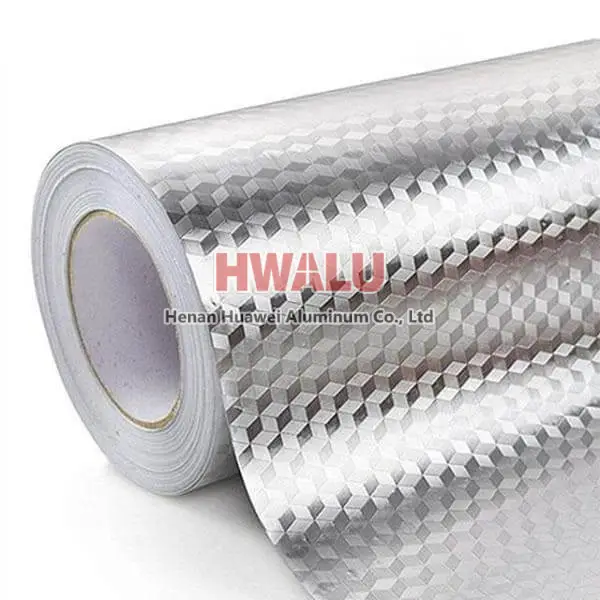Aluminum foil for flexible packaging Use 1235/1145 Aluminum foil for high temperature cooking food packaging 1235/1145 Aluminum foil for liquid food packaging 1235/1145 Aluminum foil for solid food packaging 1235/1145 Aluminum foil for pharmaceutical packaging Characteristic It has strong ductility and elongation characteristics and has good thermal stability, fewer pinholes, and good sha ...
What is aluminum foil for hookah Aluminum foil for hookah is a type of aluminum foil that is specifically designed and marketed for use in hookahs or water pipes. It is commonly used to cover the bowl of the hookah and hold the tobacco or shisha that is smoked through the pipe. Hookah foil is typically thinner than other types of aluminum foil, making it more pliable and easier to fit over the hookah bowl. It ...
Single zero aluminum foil refers to aluminum foil with a thickness between 0.01mm ( 10 micron ) and 0.1mm ( 100 micron ). 0.01mm ( 10 micron ), 0.011mm ( 11 micron ), 0.012mm ( 12 micron ), 0.13mm ( 13 micron ), 0.14mm ( 14 micron ), 0.15mm ( 15 micron ), 0.16mm ( 16 micron ), 0.17mm ( 17 micron ), 0.18mm ( 18 micron ), 0.19mm ( 19 micron ) 0.02mm ( 20 micron ), 0.021mm ( 21 micron ), 0.022mm ( 22 micron ...
what is 8021 alloy aluminum foil? 8021 alloy aluminum foil has excellent moisture resistance, shading, and extremely high barrier ability: elongation, puncture resistance, and strong sealing performance. The aluminum foil after compounding, printing, and gluing is widely used as a packaging material. Mainly used for food packaging, blister drug packaging, soft battery packs, etc. The Advantages Of 8021 a ...
What is Extra-heavy duty aluminum foil Extra-heavy duty aluminum foil is a type of aluminum foil that is thicker and more durable than standard or heavy-duty aluminum foil. It is designed to withstand higher temperatures and provide extra strength, making it suitable for more demanding applications in the kitchen and beyond. Extra-heavy duty aluminum foil common alloys The common alloy used for extra-heavy ...
1.Convenience: Large rolls of aluminum foil can be cut at any time, convenient for packaging food of various shapes and sizes, very flexible. 2.Freshness preservation: Aluminum foil can effectively isolate air and moisture, prevent food from going bad, and prolong the freshness period of food. 3.Durability: Aluminum foil has excellent heat resistance and tear resistance, can withstand high temperature and p ...
Aluminum foil is recyclable. Due to the high purity of aluminum foil materials, they can be reprocessed into various aluminum products after recycling, such as food packaging, construction materials, etc. Recycling aluminum, meanwhile, is an energy-saving process that involves melting down aluminum scrap to create new aluminum products. Compared to producing aluminum from raw materials, the recycling process of a ...
https://www.youtube.com/watch?v=ZR_JvbVongU The shocking statistics released by the National Center for Cardiovascular Diseases suggest that China has the highest occurrence of sudden cardiac deaths (SCD) in the world, accounting for over 544,000 deaths annually. That is to say, SCDs occur at a rate of 1,500 people/day or one person/minute in China. According to David Jin, general manager of Henan Huawei Alumi ...
Household foil is widely used in cooking, freezing, preservation, baking and other industries. The disposable aluminum foil paper has the advantages of convenient use, safety, sanitation, no odor and no leakage. In the refrigerator or freezer, aluminum foil can be directly wrapped on the food, which can keep the food from deformation, avoid the water loss of fish, vegetables, fruits and dishes, and prevent the le ...
Packaging: food packaging, pharmaceutical packaging, cosmetic packaging, tobacco packaging, etc. This is because aluminum foil can effectively isolate light, oxygen, water, and bacteria, protecting the freshness and quality of products. Kitchen supplies: bakeware, oven trays, barbecue racks, etc. This is because the aluminum foil can effectively distribute the heat, making the food baked more evenly. In ...
Extra-wide aluminum foil serves several purposes and finds applications in various industries. Here are some common uses for extra-wide aluminum foil: Extra wide aluminum foil for Industrial Insulation: Extra-wide aluminum foil is often used for insulation in industrial settings. It is effective in reflecting radiant heat, making it suitable for insulating large areas in construction, manufacturing, and oth ...









